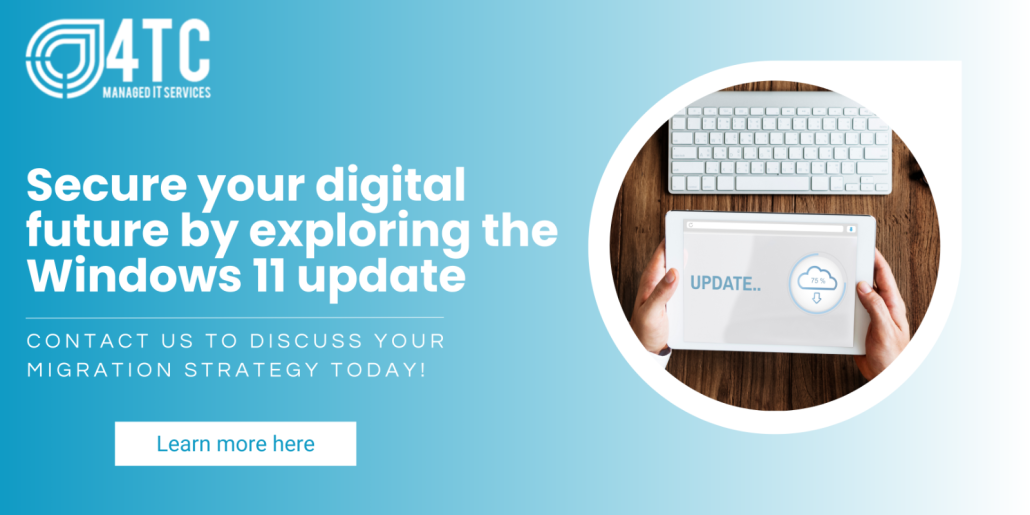Latest News for 4TC
We have loads to say!
We have loads to say!
In our last piece we discussed the withdrawal of updates and support for Windows 10 by Microsoft, which is prompting many businesses to make the switch to Windows 11. In this piece, we give you guidance and insights into making a more seamless transition to Windows 11.
As discussed in our last piece, it’s possible to transition from Windows 10 to Windows 11 for free! Before making the transition, a key thing to explore is making sure that devices meet the compatibility requirements beforehand.
It’s likely this will not be an issue for your devices, but it’s better to look before you leap! There are certain other requirements as well that can obstruct adopting Windows 11, such as Trusted Platform Module (TPM) 2.0 requirements, which may be resolved by manually enabling it on the device if there is an issue.
If you find that any devices are not able to support Windows 11, they will either need to be upgraded, replaced, or have Extended Security Updates (ESUs) purchased from them, which can offer a lifeline of continued security for a price.
No date has been confirmed as of yet for the end-of-life support for Windows 11, but it’s looking very unlikely that it will be anytime soon. One reason is because Microsoft has not yet released a successor OS, Windows 12 yet, which is due to be released in 2024. Even so, it will be several years until Windows 11 is no longer supported by Microsoft.
Given that the upgrade is free and can be done at the click of a button, making the transition is a simple enough process on the surface. This said, depending on the size, complexity and setup of your organization, there are some important things to consider ahead of and during the transition.
These include:
· Prepare Your Team: Not just notifying the team of the rollout, but also this is an opportunity to help them to take advantage of Windows 11’s new features in their daily work!
· Systematise the rollout with cloud configuration tools: Cloud configuration tools like Intune, Windows Autopilot, and Configuration manager can be used to systematically roll out the upgrade without missing a beat.
· Update your Documentation: Windows 11 will have a different visual layout compared to Windows 10 in some key respects, so if your organization offers step-by-step guides, it will be important to update the processes, terminology and images in them appropriately. · Validate your IT environment with Windows 11: Microsoft offers a free Insider Program that enables you to ensure your software and hardware will work as intended ahead of a rollout.
· Conduct a Phased Rollout: Depending on the size of your organisation, a phased rollout can help to ensure a smoother, less disruptive process that identifies gaps, and implements best practices along the way.
Here are some of the range of benefits of transitioning to Windows 11 for users and businesses more broadly:
· Elevated Performance and Efficiency: With improved resource management and faster load times, Windows 11 offers better device performance to your business.
· Revamped User Interface: more than skin-deep, the revamped user interface is designed (although not all will agree!) to offer a sleeker user experience.
· Integrated Teams in Taskbar: ensures that your team can connect with colleagues with a single click.
· Enhanced Cyber Security Features: From the ground up, Windows 11 does come with more in-built security features that align with the zero-trust security model, an increasing standard for ensuring better business security.
· Direct Access to Android Apps: Windows 11 offers direct access to Android apps via the Microsoft store and Amazon appstore, which can bring together mobile and desktop experiences for users in organisations using both Android and Microsoft devices.
· Optimised for the Latest Hardware and Software: Configured for the latest hardware and being the most compatible of the Windows OSes with the latest softwares, Windows 11 will correlate to better performance for businesses in both areas.
4TC can help! We can ensure that all aspects of your IT environment are ready for the upgrade to Windows 11, so that your business enjoys a smooth and harmonious transition. Sooner is better than later when it comes down to getting the best out of your business’s security and performance. Get in touch with us today and we’ll be glad to help you to take the next steps.
4TC can support you with all the services you need to run your business effectively, from email and domain hosting to fully managing your whole IT infrastructure. Setting up a great IT infrastructure is just the first step. Keeping it up-to-date, safe and performing at its peak requires consistent attention.
We can act as either your IT department or to supplement an existing IT department. We pride ourselves in developing long-term relationships that add value to your business, with high quality managed support, expert strategic advice, and professional project management. Get assistance with your IT challenges today by getting in touch, we’ll be glad to assist you!

Microsoft has announced that support for Windows 10 is going to stop before the end of 2025, which means that updates and security fixes will no longer be rolled out by default to business devices that still use this operating system (OS). If your business is still using Windows 10, don’t fret! In this blog we explore what this means for your business, some considerations around security, compliance and performance, and what next steps you can take forward.
All good things must come to an end, and the same is true for Windows 10. Like other previous operating systems like Windows Vista and 7, Windows 10 will eventually be put to rest in Microsoft’s graveyard of operating systems.
After the cut-off date in 2025, devices using Windows 10 will still work as you’d expect, but there are important consequences to the support cut-off that will become increasingly important for any business that sticks with this OS.
Because security and performance updates will cease to be released following the cut-off, devices will eventually become more vulnerable, unreliable and prone to performance issues over time. With this also being public knowledge, cyber criminals will be poised to try to take advantage of this support cut-off too.
Over time, other software and hardware providers will also stop developing and configuring their products to work with Windows 10 which will gradually increase compatibility issues over time for devices still using this OS.
As you’ll likely know, Window’s 11 is out and will be in support for the foreseeable future. Eventually, every business will need to make the switch to it, so what’s in store?
Released 2 years ago, Windows 11 offers several new features including design changes and enhanced performance compared to Windows 10. Much of the changes are design based, featuring a more apple-esque appearance on its menus, the desktop taskbar is integrated with Microsoft 365 tools, particularly teams, and there are improved widgets and snap-layouts that are designed to make multi-tasking easier.
Yes! Microsoft offers ESUs (Extended Security Update) products for old OSes, usually for roughly around 5 years after their initial cut-off point like the one we’re discussing here. However, these can be quite expensive to purchase for every device, and it is a yearly cost.
There are a number of reasons why sticking with Microsoft 10 can be risky and sub-optimal for your business, especially if you do not get purchase ESUs. They include:
· Windows 10 will receive less focus from developers, even as we approach the 2025 cut-off
· Businesses will miss out on updates and new features from Microsoft, which will become increasingly exclusive to Windows 11
· The cyber security risks of unsupported Windows 10 devices can lead to financial, reputational and operational losses if a cyber threat causes harm.
· Alongside general cyber security risks, businesses operating unsupported Windows 10 devices may also put their compliance at risk, as they may be seen as not taking reasonable measures to ensure the integrity of sensitive data for example.
We would ultimately recommend switching to Windows 11, and doing so well ahead of the support cut-off point in 2025. Windows 11 is a free upgrade on Windows 10 devices now, but for some organisations it will be important to plan the change, to make sure the transition is seamless and avoids causing inadvertent disruption.
We will explore making the transition to Windows 11 in our next article to offer some guidance for your business, stay tuned! If you’d like insights and advice tailored to your situation, you can also get in touch and we’ll be glad to help you.
4TC can support you with all the services you need to run your business effectively, from email and domain hosting to fully managing your whole IT infrastructure. Setting up a great IT infrastructure is just the first step. Keeping it up-to-date, safe and performing at its peak requires consistent attention.
We can act as either your IT department or to supplement an existing IT department. We pride ourselves in developing long-term relationships that add value to your business, with high quality managed support, expert strategic advice, and professional project management. Get assistance with your IT challenges today by getting in touch, we’ll be glad to assist you!

Artificial Intelligence is undoubtedly the buzzword of our time. Its popularity, particularly with the emergence of generative AI applications like ChatGPT, has brought it to the forefront of technological debates.
Everyone is talking about the impact of AI generative apps like ChatGPT and whether it is fair to take advantage of their capabilities. However, amid all this perfect storm, there has been a sudden surge of numerous myths and misconceptions around the term Artificial Intelligence or AI.
I bet you might have heard many of these already! Let’s dive deep into these myths, shatter them, and understand the true nature of AI.
Contrary to popular belief, AI isn’t intelligent at all. Most people nowadays do think that AI-powered models are intelligent indeed. This might be led by the inclusion of the term “intelligence” within the name “artificial intelligence”
But what does intelligence mean?
Intelligence is a trait unique to living organisms defined as the ability to acquire and apply knowledge and skills. This means that intelligence allows living organisms to interact with their surroundings, and thus, learn how to survive.
AI, on the other hand, is a machine simulation designed to mimic certain aspects of this natural intelligence. Most AI applications we interact with, especially in business and online platforms, rely on machine learning.

These are specialized AI systems trained on specific tasks using vast amounts of data. They excel in their designated tasks, whether it’s playing a game, translating languages, or recognizing images.
However, out of their scope, they are usually quite useless… The concept of an AI possessing human-like intelligence across a spectrum of tasks is termed general AI, and we are far from achieving this milestone.
The race among tech giants often revolves around boasting the sheer size of their AI models. Llama’s 2 open-source LLM launch surprised us with a mighty 70 billion features version, while Google’s Palma stands at 540 billion features and OpenAI’s latest launch ChatGPT4 shines with 1.8 trillion features. However, the LLM’s amount of billion features doesn’t necessarily translate to better performance.
The quality of the data and the training methodology are often more critical determinants of a model’s performance and accuracy. This has already been proved with the Alpaca experiment by Stanford where a simple 7 billion features powered Llama-based LLM could tie the astonishing 176 billion features powered ChatGPT 3.5.
So this is a clear NO!
Bigger is not always better. Optimizing both the size of LLMs and their corresponding performance will democratize the usage of these models locally and allow us to integrate them into our daily devices.
A common misconception is that AI is a mysterious black box, devoid of any transparency. In reality, while AI systems can be complex and are still quite opaque, significant efforts are being made to enhance their transparency and accountability. Regulatory bodies are pushing for ethical and responsible AI utilization. Important movements like the Stanford AI Transparency Report and the European AI Act are aimed to prompt companies to enhance their AI transparency and provide a basis for governments to formulate regulations in this emerging domain?.
Transparent AI has emerged as a focal discussion point in the AI community, encompassing a myriad of issues such as the processes allowing individuals to ascertain the thorough testing of AI models and understanding the rationale behind AI decisions. This is why data professionals all over the world are already working on methods to make AI models more transparent.
So while this might be partially true, it is not as severe as common though!
Many believe that AI systems are perfect and incapable of errors. This is far from the truth. Like any system, AI’s performance is contingent on the quality of its training data. And this data is often, not to say always, created or curated by humans.
If this data contains biases, the AI system will inadvertently perpetuate them.
An MIT team’s analysis of widely-used pretrained language models revealed pronounced biases in associating gender with certain professions and emotions. For example, roles such as flight attendant, or secretary were mainly tied to feminine qualities, while lawyer and judge were connected to masculine traits. The same behavior has been observed emotion-wise. Other detected biases are regarding race. As LLMs find their way into healthcare systems, fears arise that they might perpetuate detrimental race-based medical practices, mirroring the biases inherent in the training data.
It’s essential for human intervention to oversee and correct these shortcomings, ensuring AI’s reliability. The key lies in using representative and unbiased data and conducting algorithmic audits to counteract these biases.
One of the most widespread fears is that AI will lead to mass unemployment.
History, however, suggests that while technology might render certain jobs obsolete, it simultaneously births new industries and opportunities. For instance, the World Economic Forum projected that while AI might replace 85 million jobs by 2025, it will create 97 million new ones.
The final and most dystopian one. Popular culture, with movies like The Matrix and Terminator, paints a grim picture of AI’s potential to enslave humanity.
While influential voices like Elon Musk and Stephen Hawking have expressed concerns, the current state of AI is far from this dystopian image.
Today’s AI models, such as ChatGPT, are designed to assist with specific tasks and don’t possess the capabilities or motivations depicted in sci-fi tales.
So for now… we are still safe!
In conclusion, as AI continues to evolve and integrate into our daily lives, it’s crucial to separate fact from fiction.
Only with a clear understanding can we harness its full potential and address its challenges responsibly. Myths can cloud judgment and impede progress.
Armed with knowledge and a clear understanding of AI’s actual scope, we can move forward, ensuring that the technology serves humanity’s best interests.
Source: 6 Artificial Intelligence Myths Debunked: Separating Fact from Fiction – KDnuggets
Worldwide, spending by businesses on cloud computing infrastructure is forecast to top $1 trillion for the first time in 2024. This will be driven by factors such as a growing need to adopt new platforms and as-a-service offerings, including artificial intelligence (AI) services.
This is because, in 2024, businesses are looking beyond the time-and-money-saving opportunities of cloud migration. Emerging use cases across all industries make it clear that it can often be the key to becoming more innovative, agile and successful.
For many businesses, there will still be significant challenges – often revolving around security and data protection issues. However, new models that seek to offer best-of-all-worlds solutions, like hybrid cloud and federated cloud systems, will continue to break down barriers.
In 2024, cloud will continue to be a dynamic and exciting driver of innovation and opportunity. Here’s my overview of what will be the most significant trends in this field.
The number of large organizations with a multi-cloud strategy (i.e., they buy cloud services from more than one provider) is predicted to rise from 76% to 85% during 2024. It offers cost and flexibility advantages but adds complexity to data governance and integration with legacy systems. Multi and hybrid cloud (mixing cloud with on-premises infrastructure) are advanced infrastructure solutions that will continue to grow in popularity as organizations seek to balance security with flexibility and pick and choose the services they need.
During 2024, organizations will increasingly look to leverage real-time data in order to get up-to-the-minute insights rather than acting on outdated, stale information. At the same time, more and more of the data we consume will come in the form of streamed data – movies and music from Netflix and Spotify, video data from Zoom or Teams calls, and new forms of streamed entertainment such as cloud gaming. This means data storage that prioritizes instant access, such as Flash and solid-state storage devices, will become increasingly in demand by cloud customers.
As well as AI mentioned above, adopting cloud computing technology can be a gateway to many other transformative technologies such as the Internet of Things (IoT), blockchain and quantum computing. By eliminating the need to invest directly in architecture and infrastructure, businesses are able to launch quick-win/fail-fast initiatives to evaluate the benefits of emerging technologies more easily than ever in 2024, thanks to cloud computing.
Encryption, authentication and disaster recovery are three functions of cloud computing services that will be increasingly in demand as we face up to the evolving threat landscape of 2024. Data thefts and breaches are increasing in frequency and severity as hackers develop new AI-powered forms of attack, and any system that has to be accessible to a human is always going to be at risk from social engineering attacks. This means security and resilience are high on the agenda of all cloud providers and customers.
The big cloud service providers have all made net-zero commitments, not just for their own operations but in order to help customers who use their services to reduce their carbon footprints. Amazon has pledged to achieve zero emissions by 2040, and Microsoft aims to beat this by ten years. Along with Google, they have also all stated their intention to generate 100 percent of the energy used in their operations from renewable sources. Whether they make it remains to be seen, but the push for greener and less environmentally impactful cloud computing will be a strong trend in 2024.
Today, low-code/ no-code tools are opening up the possibility for non-technical people to create applications that previously would have required trained software engineers. Likewise, cloud providers are leveraging drag-and-drop interfaces and natural language tools to eliminate the need for advanced technical skills and “democratize” the deployment and management of cloud services and infrastructure.
Cloud privacy refers to the ongoing development of technological, regulatory and legislative solutions designed to help businesses leverage cloud while ensuring their customers can trust that their data is fully protected. When a business uses a cloud service, it generally involves passing data to a third party – usually the cloud service provider. Managing the privacy implications of this will continue to be an important theme in cloud computing during 2024.
Serverless is a model of cloud computing service that eliminates the need for businesses to manage their own servers. While a typical cloud service might charge the business for the number of servers that they want to host their infrastructure on, under a serverless model, the business simply pays for the resources they directly use. This drives efficiency by eliminating the need to pay for servers even when they are not in use and frees up the business’s time to spend on their core activities.
Edge computing is a cloud-related paradigm in which information is processed as close as possible to the location where it’s collected. An example might be a wearable real-time heart monitor designed to pick up arrhythmias. As most of the data it collects would be “normal” heart rhythms, sending it all to the cloud for analysis, then back to the user to tell them everything is fine, would be a waste of bandwidth. Analyzing the data on the device itself eliminates this cost and also means the user can be alerted more quickly if anomalous data is detected. In 2024, smaller, more power-efficient processors, more memory-efficient algorithms, and advanced networks like 5G all contribute to making edge increasingly viable for a growing number of applications.
Source: The 10 Biggest Cloud Computing Trends In 2024 Everyone Must Be Ready For Now (forbes.com)
Cybersecurity firms are increasingly looking at integrated platforms to provide holistic online security for both for their B2B and end users as disconnected point tools struggle to support enterprise security requirements
The main reason that cybersecurity companies give for focusing on development of integrated platforms is that they make it easier for companies to provide a comprehensive solution to a problem that is “categorised by its complexity and constant evolution” says Kartik Shahani, Country Manager, Tenable India.
Integrated platforms provide solutions to this problem. A 2020 IBM survey found that organisations deploy approximately 45 solutions on average, with most requiring coordination across 19 security tools.
(For top technology news of the day, subscribe to our tech newsletter Today’s Cache)
Integrated cybersecurity platforms “equip security teams with a holistic view of the entire attack surface and amalgamates diverse elements, including vulnerability management, cloud security, web app security, identity security, and attack surface management,” Shahani says.
Essentially, integrated platforms are better equipped at identifying threats, filling gaps in security, and mitigating threats due to the ability to collate and use information gathered from different areas of a network.
These platforms offer consolidated risk insights, exposure analytics, prioritises risk, recommends remediation strategies, and quantifies the reduction of cyber risk, he added.
Use of cloud-based computing has further allowed cybersecurity firms to provide access to their integrated platforms without requiring users to upgrade their systems. Integrated platforms from most firms have been designed to be easily integrated into organisation’s existing tech stacks, while also allowing customisations based on the user’s needs.
In some cases, “customers are beginning to pay on consumption basis rather than a subscription,” Binod Singh, CEO and Chairman, Cross Identity said.
Integrated platforms are also increasingly finding takers in businesses due to their economic advantage, the lack of skilled personnel to manage security apparatus, and improved visibility of gaps in security for enterprises.
Businesses looking to cut costs may pivot to integrated platforms as there is minimal overlap in the implementation and identification of security products. Further, the use of integrated platforms also allows enterprises to sidestep the problem of hiring cybersecurity experts, which can be a problem due to the lack of skilled personnel in the domain.
With the benefits of integrated platforms, B2B organisations with complex IT environments are increasingly adopting unified platforms for monitoring and responding to security threats.
“B2B organizations are embracing integrated cybersecurity systems because they provide robust protection, simplify management, offer cost savings, adapt to changing needs, support regulatory compliance, and enhance the ability to respond to threats quickly and effectively,” Ritesh Chopra, Director Sales & Field Marketing, India and SAARC Countries, Norton, said.
Small and medium-sized enterprises in India with a view to restrict expenditure, which earlier involved adopting multiple points solutions on individual licenses or subscriptions, are now increasingly turning to integrated platforms. The adoption of these platforms is aimed at bolstering security posture in accordance with the laws of the land without the overwhelming costs and complexities associated with managing multiple standalone security tools.
An of integrated cybersecurity platforms has its benefits for enterprises, it poses a challenge for startups in the cybersecurity space which may struggle to finding the right constellation of cybersecurity experts to develop all the features needed be truly comprehensive. “Most often, the best experts are specialized in topics such as threat intelligence, malware analysis, application security, data loss prevention, network security, vulnerability management, AI, privacy, etc. Thers is also a shortage of these experts on the market, which indeed presents a challenge to startups,” Chopra said.
For the end users, integrated platforms allow cybersecurity companies to present users with an all-round security solution, which while may not be a silver bullet, ensures protection across devices which may not be possible with point security solutions.
Source: How are cybersecurity firms adapting to gen AI – The Hindu
Despite plenty of misgivings, artificial intelligence—and in particular, generative AI that produces text and images from prompts—continues to be pushed into the hardware and software we use every day.
Microsoft has been active in the space, adding AI chatbot capabilities to its Bing search engine earlier this year, and it’s now previewing an early version of its new Copilot AI assistant in Windows 11.
Copilot has been built to “enhance your creativity and productivity,” Microsoft says, and it works in a similar way to Bing’s chatbot—capable of coming up with everything from travel advice to an original poem.
To get Copilot in Windows 11, make sure you’re running the very latest version of the operating system: Head to Windows Update in Settings to check (you might need to turn on the Get the latest updates as soon as they’re available toggle switch).
By default, you should see a Copilot button on the taskbar, which you can click to launch it (head to Personalization then Taskbar in Settings if you want to change this). You can also launch Copilot with the Win+C keyboard shortcut, or via the Start menu.
If you’re completely new to generative AI, just dive in and try something: You can tell Copilot to compose a short poem, an introduction to a cover letter, or text for an email to a coworker. When you start a new chat, you’ll see you can choose between More Creative, More Balanced, and More Precise conversation styles, just like Bing Chat on the web—so you can tweak how imaginative Copilot gets with its responses.
You’re not just limited to generating text though, because you can ask Copilot questions as well. Thanks to its links to Bing and the web, it can tell you about the must-see sights in a particular place, give you cooking and recipe tips, or offer advice on the best ways to fix a DIY problem around the home. You’ll see that the responses come with links to where the information has been sourced from online.

After each response from Copilot, you’ll be given a list of suggested ways to continue the conversation, or you can come up with your own follow-up questions. If you want to start over again, click the New topic button (the blue bubble) at the bottom. Meanwhile, hover over any Copilot output with the cursor and you’ll see you can copy the text (as well as give feedback on how good the response was).
Copilot can code, too. Tell it what you want your code to do, and which language you want it in, and you’ll get formatted code back in return that you can copy and paste elsewhere. As with everything else that the AI bot does, you can ask for edits and tweaks to the original response, without having to start again from scratch.

Thanks to Dall-E integration, Copilot is able to generate images as well. Tell it what you want a picture of, and in what style, and after a few moments you’ll get a choice of four options—together with follow-up ideas you can use to change the output (you might want to take something out of the scene or add something in, for example, or change some of the colors used).
Click on any image to see it full size and download it—these links actually open up on the web, showing how closely Copilot is currently linked to Bing Chat. There’s also an Add an image button in the input box, which you can use to upload pictures: Copilot can tell you about what’s in the picture, or use it as the basis of a new image.
Everything we’ve talked about so far matches what Bing Chat can already do on the web, and it’s really the integration with the Windows 11 operating system itself that sets Copilot apart. This is also the functionality that’s newest and still under construction—bear in mind that you’re using an early preview version of Copilot.
One basic task that Copilot is able to do is open up programs for you—just type “open” followed by the app name, and your bidding is done (you will see a confirmation dialog first, which seems somewhat redundant). Click on the microphone button in the input box, and you can speak out your requests instead, which you might find easier.

As well as opening the apps in question, Copilot can also tell you how to use them or help with troubleshooting problems. A few suggestions along these lines will pop up every time you open up a program in Windows 11, so it can be a useful way of exploring what a particular software tool can do for you.
A variety of Windows 11 commands work in Copilot as well: Try “mute volume” for example, though it seems a rather convoluted way of doing it compared with just tapping an icon or pressing a button on your keyboard. Again, you’ll get a prompt dialog on screen, to make sure the AI bot is exactly sure about what it is you want to do
Other commands that work include “turn on do not disturb” and “turn on dark mode,” which both save you a trip through the Settings screens. Speaking of Settings, you can ask Copilot to bring up a particular options screen—relating to Wi-Fi, for example, or changing the configuration of the Start menu—and it’ll appear in a second or two (together with related instructions about how to use it).
What Copilot can’t do yet is much inside your programs—even the ones developed by Microsoft. For it to be a truly useful digital AI assistant, it would be helpful for it to be able to view and manipulate elements inside apps: Right now, this only works with Edge, and you can enable this by clicking the three dots (top right), then Settings, and turning on the Let Copilot in Windows use Microsoft Edge content toggle switch.
Source: Here’s Everything You Can Do With Copilot, the Generative AI Assistant on Windows 11 | WIRED UK

Email: support@4tc.co.uk
Tel: 020 7250 3840
5th Floor, 167‑169 Great Portland Street
London
W1W 5PF
Dew Gates The Street
High Roding
Essex
CM6 1NT

